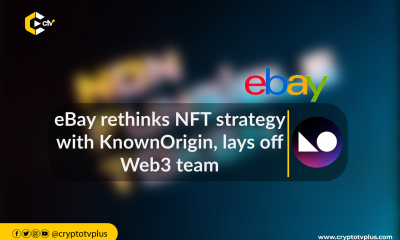FEATURED
Investing in Web3: The Power of Narrative

Investing has always been about finding opportunities and backing them with conviction. While the traditional approach has been to rely on data and fundamentals, a new wave of investors is emerging, who believe in investing based on narratives. This is known as narrative investing, and it’s taking the investing world by storm.
Web3, which encompasses blockchain, decentralized finance (DeFi), and other related technologies, is generating a lot of hype, and with good reason. It is a world where new technologies and ideas emerge every day. Hence narrative investing has become even more relevant.
Narrative investing involves investing in a company or technology based on the story that surrounds it. This strategy has been gaining popularity in recent years, with investors looking for opportunities to capitalize on emerging trends and ideas.
In Web3, narratives can be powerful drivers of investment decisions. Investors are drawn to compelling narratives that promise to change the world, and many Web3 projects offer exactly that. But what does narrative investing look like in practice, and how can investors ride the hype?
Web3 Investing Across the Cap Structure
One way to invest in Web3 is across the cap structure. The cap structure refers to the different types of equity and debt securities a company can issue, such as common shares, preferred shares, and bonds. It involves investing in Web3 startups at various stages of their growth, from early-stage startups to more mature companies.
In Web3, many startups are raising funds through initial DEX offerings (IDOs) or initial exchange offerings (IEOs), which are similar to traditional initial public offerings (IPOs). Investors can invest in these offerings through tokens, which are digital assets that represent ownership or a stake in a project. Some tokens, such as utility tokens, give holders access to a product or service, while others, such as security tokens, represent ownership in a company.
Let’s use the blockchain-based payment platform, Chain.com as an example. Chain.com was founded in 2014 and provides a secure and transparent platform for financial institutions to conduct transactions using blockchain technology. The company raised over $40 million in funding from investors, including strategic investors such as Visa, Nasdaq, Khosla Ventures, RRE Ventures, and Thrive Capital.
In addition to traditional venture capital funding, Chain.com has also raised capital through an initial coin offering (ICO), which is a type of crowdfunding using cryptocurrency. Chain.com’s ICO raised over $30 million in funding, allowing the company to expand its services and reach.
In 2018, Chain.com was acquired by Lightyear, a company that was created by the co-founder of the Stellar network, which is another blockchain-based payment system. The combined company was renamed Interstellar, and it continues to offer blockchain solutions for enterprises.
Investors can also participate in this market across the cap structure, from large-cap coins like Bitcoin and Ethereum to small-cap altcoins with potentially high returns. However, with a plethora of cryptocurrencies available, it is important to identify narratives that underpin the investments.
Chain.com’s success is an example of Web3 investing across the cap structure. The company has received funding from both early-stage angel investors and more established investors such as Visa and Nasdaq. By investing in Chain.com at different stages of its growth, investors were able to diversify their portfolios and potentially realize significant returns on their investments.
Angel Investing in Web3 Startups
Another way to invest in Web3 is through angel investing. Angel investing involves investing in early-stage startups, often before they have a product or revenue. With the explosive growth of Web3, there is an endless stream of new startups that are seeking funding. This has created a unique opportunity for angel investors to get in on the ground floor of the next big thing.
Angel investors in Web3 typically invest in startups that are focused on decentralized finance, NFTs, or other Web3 technologies. These startups are often led by experienced entrepreneurs who have a deep understanding of the technology and the potential for disruption.
Early-stage startups that align with specific narratives, such as decentralized finance or Web3 infrastructure, are particularly attractive to angel investors seeking to invest in the next big thing.
One real-life example of angel Web3 investing is the popular cryptocurrency exchange, Coinbase. The company was founded in 2012 by Brian Armstrong and Fred Ehrsam and has since grown to become one of the largest cryptocurrency exchanges in the world, with over 43 million users as of 2023. Nine million of these users were active more than once a month on Coinbase in 2022, a slight increase from the 8.8 million active in 2021.
Coinbase offers a platform for buying, selling, and storing various cryptocurrencies, including Bitcoin, Ethereum, and Litecoin. The company has raised over $500 million in funding from investors, including several angel investors, such as Garry Tan, Alexis Ohanian, and Paul Buchheit.
These angel investors recognized the potential of Coinbase early on and made strategic investments in the company. Their investments helped to fuel Coinbase’s growth and success, and they were able to realize significant returns on their investment when the company went public in April 2021.
Angel Investors must be able to evaluate the team, the product, and the potential market size. They must also be able to identify promising narratives and differentiate them from hype. While the risks associated with early-stage investing are high, the potential rewards can be enormous.
Coinbase’s success is a prime example of the potential for significant returns on investment in the Web3 space. The company has disrupted the traditional financial industry by offering a decentralized and transparent platform for buying and selling cryptocurrencies, and its success has inspired a new generation of Web3 startups.
Narratives in Web3 Investing
Narratives play a critical role in Web3 investing. In this context, narratives refer to the stories that investors tell themselves and others about why a particular technology or company is valuable. These narratives can be powerful drivers of investor behaviour, as they create a shared understanding of what is valuable and why.
For example, the narrative around decentralized finance is that it has the potential to disrupt traditional finance and make it more accessible to everyone. This narrative has been a driving force behind the explosive growth of decentralised finance over the past year.
A strong narrative can generate interest in a project and drive demand for the product or service. For example, the narrative around non-fungible tokens (NFTs), their potential to revolutionize the way we think about ownership, and the role that blockchain technology can play in creating a more transparent and trustworthy internet. This trend has been seen with games such as Axie Infinity and The Sandbox, where players can buy and sell virtual land, items, and creatures using cryptocurrency. The narrative is that these NFTs have real value, and as the games grow in popularity, so too will the value of the NFTs. Thus, the narrative became a driving force, with investors and collectors eager to be part of the story.
Another example is CryptoPunks, which are among the earliest NFTs on the Ethereum blockchain. Each CryptoPunk is a unique, 8-bit image of a pixelated character, and they have gained significant value due to their historical significance in the development of NFTs. Investors believe that CryptoPunks represent an important piece of Ethereum’s history, and as such, they have become a valuable investment.
Another narrative that has been popular in Web3 is the promise of “the next big thing”. Investors are often drawn to projects that promise to disrupt industries or change the world. Many Web3 projects aim to decentralize various aspects of our lives, from finance to social media. This narrative has drawn investors who believe that decentralization is the future. Hence, projects that align with this narrative, such as decentralized exchanges and blockchain-based social networks, are often viewed favourably by narrative investors.
Another narrative that has been growing slowly is that of decentralized social media. Unlike centralized social media platforms like Facebook, Twitter, Instagram where user data are controlled and can be sold to advertisers, decentralized social media platforms offer a better alternative —freedom for users to choose and be in control of their digital destiny. These platforms such as Lens protocol are becoming a top choice for crypto natives. This need to be in charge of their digital destiny on social media is why decentralized social media platforms are popping up across the cryptosphere.
The Risks of Narrative Investing
While narrative investing can be a powerful tool, it’s not without risks. One of the biggest risks is that narratives can be driven by hype and speculation rather than fundamentals for example, memecoins. This can lead to inflated valuations and a bubble mentality, which can be dangerous for investors.
Another risk is that narratives can change quickly, and investors who are slow to adapt can be left holding the bag. In the fast-paced world of Web3, it’s essential to stay on top of the latest developments and be ready to pivot when necessary.
Conclusion
Narrative investing has emerged as a viable investment strategy in the web3 world. However, it is important to note that narrative investing can be a double-edged sword.
Narratives create excitement and drive investment. But some narratives may promise more than they can deliver, and thus can also be misleading. It can lead to hype and overvaluation, with investors chasing the latest narrative without fully understanding the underlying technology or potential risks. In such cases, investors must be able to separate hype from reality.
As the ecosystem continues to evolve, investors should be mindful of emerging narratives and consider the underlying technology and potential risks. It is important to conduct thorough due diligence and understand the fundamentals of the investment. Investors who can identify promising narratives and evaluate projects based on their potential for success can ride the hype and see significant returns in this exciting new space.
Read also: Why do people buy NFTs?

























Pingback: Investing in Web3: The Power of Narrative - CryptoHubLive.com
Pingback: Investing in Web3: The Power of Narrative by Kyrian Alex – CryptoTvplus Events: NFT, DeFi, Bitcoin, Ethereum, Altcoin Events
Pingback: Investing in Web3: The Power of Narrative - Crypto News Wire
Pingback: Arsenal FC & Staynex NFT to Launch Journey Pass | CryptoTvplus: DeFi, NFT, Bitcoin, Ethereum Altcoin, Cryptocurrency & Blockchain News, Interviews, Research, Shows
Pingback: Arsenal FC & Staynex NFT to Launch Journey Pass – TheDigitalAssetTimes.info